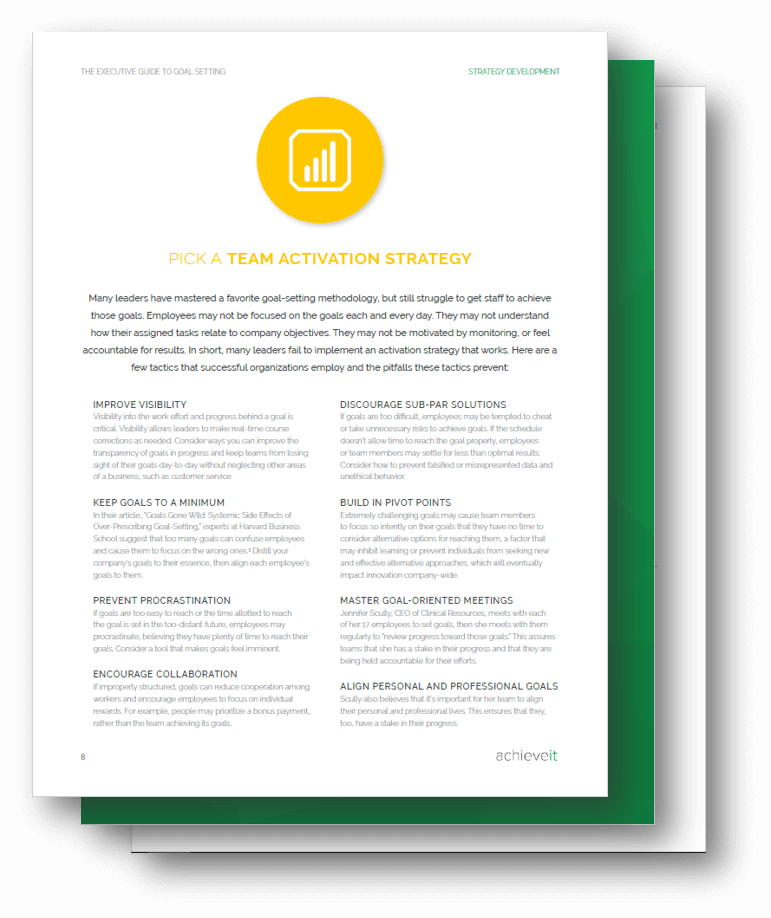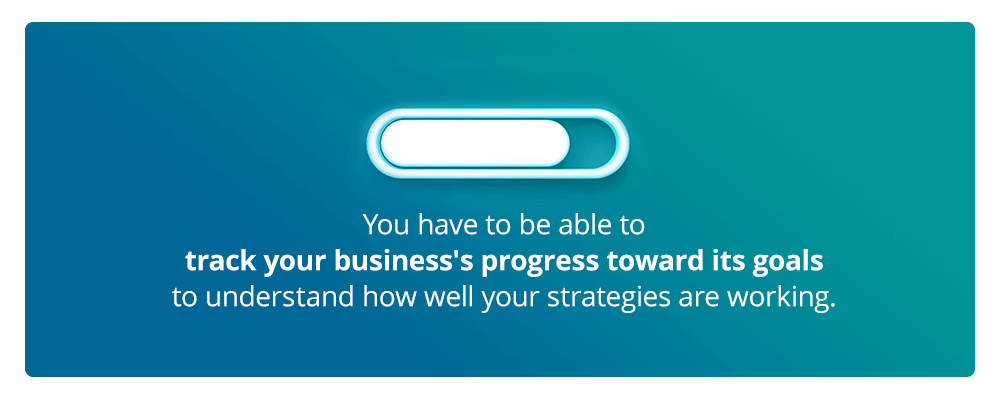Most strategic and operational plans ignore the definition of strategic objectives. Objectives are often merely an assortment of task lists submitted by various executives and managers. Someone compiles these lists, puts them into a three-ring binder and attempts to update them on a monthly or quarterly basis.
Generally, the task lists originate from a well-orchestrated and energetic planning retreat. During this retreat, the management team reviewed the business’s mission statement and agreed on its major initiatives and goals. This process leads us into the trap of believing that these lists have real benefits.
They don’t. Because current processes lack strong strategic factors, almost 67% of strategic objectives fail, causing leaders in decision-making positions to view the system of strategic objectives and planning as something that doesn’t work. What most organizations don’t realize, however, is that these strategic business objectives are vital to the success of a strategic plan.
So how do we write objectives that truly support strategy execution best practices?
In This Article
- Understand What a Strategic Objective Is
- Choose Your Methodology for Setting Strategic Objectives
- Build Measurable Strategic Objectives
- Set Better Strategic Objectives With AchieveIt
1. Understand What a Strategic Objective Is
Strategic objectives are statements that identify what is critical or important in a company’s strategy.
On the most basic level, companies need to phrase strategic objectives in a way that answers two simple questions — “how much” and “by when.”
When learning how to incorporate strategic objectives into your business models, you should also understand how they differ from general strategic goals. Strategic objectives are broader goals that companies can use to direct business growth, connecting the company’s values in their vision statement to actionable steps and plans. These types of goals help companies break down their general goals into realistic, manageable, and achievable areas.

The key to creating successful strategic objectives is to make them essential within your strategic plan. Your business will use a baseline, target, and time to bind its goal to an objective that’s powerful, precise, and — most importantly — actionable. The baseline and target should help you answer “how much,” and time will help you determine when you can achieve your strategy.
Some of the best strategic objectives are a sentence long, begin with a verb, and include an object, a measurable unit, and a timeline. Here are some examples:
- Increase our advertising sales by 2% in the next 4 months
- Improve user engagement from 70% to 80% in a year
- Decrease client turnover by 10% in 6 months
- Hire and onboard 20 new employees by the end of this fiscal year
- Grow our marketing team by 3 before the next quarter
- Complete 20 items on our goals list by the end of this year
You will need to know the level of improvement required and how much time you both need and have to achieve the established targets. Both of these elements are essential for an actionable, executable strategy.
As you learn what strategic objectives are, you can also explore the different types. There are many categories that they could fall under depending on what you are trying to accomplish and what your focus area is. Examples of strategic objective categories include:
- Financial: These strategic objectives specifically target areas of financial growth and change, allowing companies to find areas of improvement in their current financial processes and strategies. Financial strategic goals can take many forms, including cutting costs, establishing more effective budgets, and increasing revenue.
- Growth: Growth strategic objectives aim to help businesses increase their public influence or streamline internal processes to create a stronger and more resilient business. For example, companies may want to improve their brand recognition or work to make internal operations more efficient.
- Learning: Objectives in this category are about investing in your employees. Learning objectives seek to provide your employees with increased or specified skills that will allow them to serve your company better. Many companies use learning strategic objectives to increase overall performance.
- Customer: Companies can also choose to focus their strategic objectives on their interactions with their customers. This type of strategic example is very flexible. It can focus on many aspects of the customer experience, from decreasing product or service price to improving your customer service skills.
Understanding what strategic objectives are, what sets them apart from other goals and the types of strategic objectives you can use will help you to create stronger, more practical goals for your business.
2. Choose Your Methodology for Setting Strategic Objectives
Establishing baselines, targets, and timelines helps establish your goals, setting them apart from general business strategies and tactics. Baselines and targets help provide a current performance benchmark and define the future performance you’re seeking, while time provides an idea of how aggressive the strategy needs to be.
Implementing strategies and tactics is a key part of strategic management. However, successfully carrying out those strategic plans requires knowing how to measure their success.
You can distinguish your strategic goals from general strategies by measuring an outcome rather than the process designed to achieve that outcome. When you create a strategic objective, you should carry out actions that will result in quantifiable, measurable outcomes by a specific time.
Methodology and goal-setting strategies can help you develop clear and strong strategic planning that lets you transform your goals into results.
Many businesses favor SMART goals because of their depth and level of specificity, letting you incorporate all the information your business should consider to reach your goals successfully. SMART is an acronym that stands for Specific, Measurable, Achievable, Relevant and Time-bound. Each element in the acronym brings crucial information to your strategic planning and represents different focus areas you need as you move forward from the planning to action stages:
- Specific ensures you’re targeting precise goals rather than general improvement.
- Measurable requires you to think about how you will capture your results and determine progress.
- Achievable asks you to be realistic and ensure you have the resources necessary to reach your goal.
- Relevant directs you to think about how this pertains to your business and its needs.
- Time-bound causes you to consider your timeline and when you want to achieve your goal.
These aspects will help you work toward a well-rounded plan as you develop your strategic objectives and set goals. Your methodology will be thorough, letting you better plan for implementation and acting on your goal setting.
Following are some examples of strategic objectives, but if your initiatives already check these boxes you might be ready to start tracking your plan’s execution.
FREE RESOURCE
Executive Guide to Strategic Goal Setting
Download this guide to learn how the most successful executives use goal-setting methodologies and technology to empower their teams and improve execution.

3. Build Measurable Strategic Objectives

While all SMART goal elements have individual and unique importance, measurability is especially vital. You have to be able to track your business’s progress toward its goals to understand how well your strategies are working. When creating measurability, consider where your quantifiable data is, how you will collect it, and how you will analyze it.
If you want your objective to produce quantifiable data, you’ll need a variable that reflects an amount of something. As you complete this stage, consider the factors you’ll need to measure to quantify your progress toward your goals. You could use length in inches or feet, mass in pounds, volume in gallons or liters, temperature in degrees, area in square feet, heat in BTU, and pressure in pounds per square inch. Each of these can quantify and measure an objective.
Strategic and operational planning most often uses safety, time, dollars, percentages, numerical counts, quality, satisfaction, people, and finance to measure strategic goals. By making business objectives that are quantifiable, measurable, and focused, you’ll immediately increase the chance of accomplishing your strategic plan.
Safety
You can observe and measure safety standards as you work toward your goals.
For example, if you manufacture products, you may want to implement new safety strategies and techniques like training, signs, and restricted areas to increase safety at your factories and warehouses. Companies can measure safety by tracking their numbers of workplace accidents and injuries. Comparing numbers before and after implementing a new strategy will let you measure its effectiveness.
Time
As many companies do, you may find you want to increase your efficiency in producing a product or providing a service.
For example, a mortgage company might want to reduce the time required to process a loan. A residential construction company might want to reduce the time required to frame a house. A hospital might want to reduce the time an E.R. patient spends waiting to see a physician. This is the most common metric used to meet the definition of strategic objectives.
Measuring how long it takes to complete tasks and analyzing which steps in the process are taking the longest will help you streamline and improve those specific areas.

Dollars
Another way to measure your progress is through costs. Many businesses aim to either decrease the cost of producing a product or service or increase the revenue they generate by delivering it.
For example, a mortgage company might want to decrease its loan processing costs. A construction company might want to increase the average margin on new home construction. A hospital might want to decrease average supply costs per E.R. patient.
Percentages
If your company wants to decrease or increase the rate of a process, activity, or desired outcome, you can use percentages to measure your progress.
Using our previous examples, the mortgage company might want to increase its market share percentage for total loans closed. The construction company may want to decrease the percentage of lumber rejected for failing to meet its internal specification requirements. The hospital might want to increase the percentage of E.R. patients who pay their deductibles at the point of service.
Numerical Counts
You can also use numerical counts when your business wants to decrease or increase the physical count of something.
The mortgage company might want to increase the number of loans processed. The construction company might want to decrease the number of homes that don’t pass the first inspection. The hospital might want to increase the number of E.R. patients.
Quality
You can use quality as a metric to assess your progress toward improving your products or services. You can create your own quality assessment systems or use established customer or third-party standards.
For example, if you manufacture products you can measure quality by adding a testing stage. Testing the products before they’re packaged and shipped to your warehouses or vendors will give you data on how many items pass inspections as well as common quality issues. Using this information to target areas for improvement will help you measure your progress toward producing higher-quality items.

Satisfaction
Increasing customer satisfaction is a great way to apply a customer strategic objective to your company’s goals and growth. You can use customer satisfaction as a way to measure how new customer-focused initiatives are working through surveys and site reviews.
An electronics company may try to help customers in real-time by launching a chatbox on their site. They can set the program to invite customers to fill out a short survey about their experience or rate how helpful it was after they finish using the feature. Collecting this feedback can help the company determine how satisfied customers are and if they need to make any changes.
People
People are a great way to measure objective success for both internal and customer goals. As with satisfaction, people can provide qualitative insight about their experiences, giving leadership teams essential feedback to continue progressing toward their goals. Focus groups, surveys, and forms are great ways for companies to receive feedback from people in a way they can measure and apply.
For example, a company that wants to train their employees in new office habits can ask employees to submit a form afterward outlining what they thought was effective and where the training could improve.
Finance
Many companies focus on financial growth and use their finances as a way to measure their progress. You can calculate costs, revenue, or other financial aspects your business deals with.
A company may set a goal to reduce its shipping and handling costs. After they implement new systems, comparing new and old reports on shipping and handling costs can help them judge how effective their new techniques were and whether they need to try a new approach.

Set Better Strategic Objectives With AchieveIt
Strategic objectives are essential for streamlining effective growth and change across your business’s departments and applications. The many types of strategic purposes let you target specific areas of your business for improvements, such as your customers or finances. The more specific details you include in your strategic objective, the more likely you are to consider all the information you need to succeed.
Your business’s success relies on using effective processes for creating and implementing strategic objectives. Processes that don’t incorporate the information they need to work toward success can cause many companies to give up on their goals. Tools like SMART goals and solid measurement techniques are pivotal for your business to achieve its objectives and implement successful tactics.
At AchieveIt, we dedicate ourselves to helping businesses like yours reach their goals and successfully execute new and effective strategies. Our platform automatically collects and displays data on your dashboard, saving you time from manually entering data and letting you focus more of your time on carrying out plans and strategies. You can also choose the scope of your data with AchieveIt, from individual teams and employees to the company as a whole, allowing you to assess progress and improvement.
Request a demo from AchieveIt today and begin working toward your strategic objectives.
Ready to improve your plan execution?
Organizations of all types leverage AchieveIt to manage, execute, and connect their most important initiatives. Replace manual processes & siloed systems with interconnected plans in a single, automated platform.



